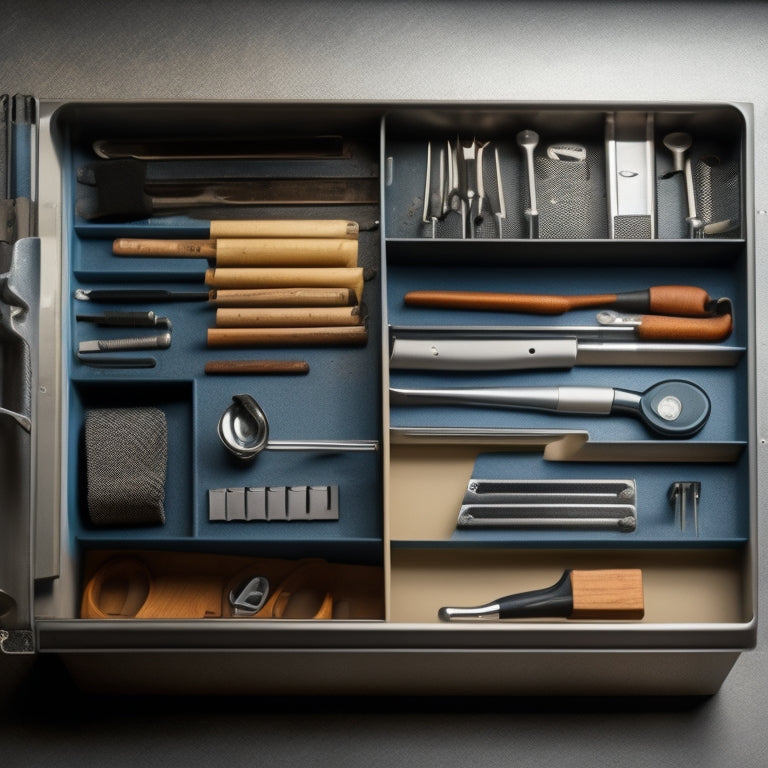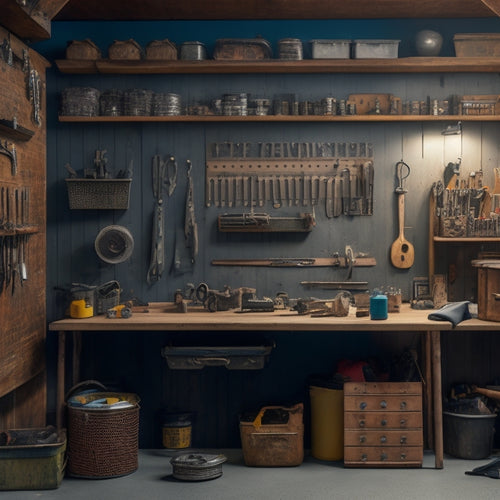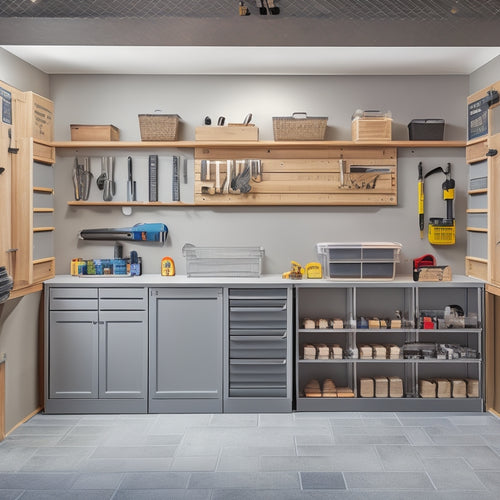
Features to Consider in a Tool Tray Organizer
Share
When selecting a tool tray organizer, you'll want to reflect on several key features to guarantee you get the right one for your needs. Start by thinking about size and capacity, as well as the design and functionality that will enhance your workspace efficiency. Material quality and durability are also essential, with rust-resistant coatings and corrosion-resistant materials like stainless steel and aluminum being ideal choices. Additionally, contemplate the organization and flexibility you need, including adjustable dividers and compartments that can be customized to fit your tool set. By evaluating these factors, you'll be well on your way to finding an organizer that streamlines your workflow and keeps your tools safe and within reach, and there's more to investigate in this vital decision-making process.
Key Takeaways
- Consider the size and capacity of the tool tray organizer based on available space and tool quantity to ensure efficient storage.
- Durable materials like stainless steel, aluminum, and fiber-reinforced polymers with rust-resistant coatings enhance the organizer's lifespan and safety.
- Adjustable dividers and customizable compartments provide flexibility in organizing tools of various shapes and sizes for optimal workspace efficiency.
- Ergonomic design features like comfortable handles, balanced weight distribution, and cushioned grips promote user comfort and reduce fatigue during transport and use.
- Easy cleaning and maintenance features like removable trays, smooth surfaces, and tool-free assembly enable quick upkeep and extend the organizer's lifespan.
Size and Capacity Options
Selecting the right tool tray organizer often starts with considering the size and capacity options. You need to think about the space you have available and the number of tools you need to store. A larger capacity organizer may be necessary if you have a wide variety of tools, but it may also take up more space. On the other hand, a smaller organizer may be more compact, but it may not hold all your tools.
When choosing a tool tray organizer, you should prioritize storage efficiency and space optimization. Look for an organizer with adjustable dividers and compartments to maximize storage capacity.
Consider the height and width of the organizer, as well as its weight capacity, to guarantee it can hold your tools safely. You should also think about the size and shape of your tools, as some organizers may be better suited for smaller or larger tools.
Material Durability and Strength
When selecting a tool tray organizer, you'll want to take into account the material's durability and strength to guarantee it can withstand heavy use.
Rust-resistant coatings are vital, as they prevent corrosion and extend the organizer's lifespan.
Additionally, the weight capacity of the organizer is significant, as it directly impacts the safety and stability of your tools and equipment.
Rust-Resistant Coatings Matter
Every tool tray organizer worth considering features rust-resistant coatings, as they play an essential role in maintaining the structure's material durability and strength. You need to verify the coating can withstand harsh environments and heavy tool loads.
Look for organizers with coatings like epoxy, polyester, or powder coating, which provide excellent rust resistance. The type of coating used can greatly impact the longevity of your tool tray organizer. For instance, epoxy coatings offer superior corrosion protection, while polyester coatings provide added durability.
When evaluating rust-resistant coatings, consider factors that affect longevity, such as the thickness of the coating, the material's porosity, and the manufacturer's application process. A high-quality coating will guarantee your tool tray organizer remains structurally sound, even in humid or wet conditions.
Additionally, rust-resistant coatings make cleaning easier, reducing the risk of tool damage and contamination. By prioritizing rust-resistant coatings, you can trust your tool tray organizer to perform reliably and safely over time.
Weight Capacity Importance
Check the tool tray organizer's weight capacity to confirm it can handle the total weight of your tools and equipment. You don't want your organizer to collapse or break, causing damage to your tools or, worse, physical harm to you or others.
A sturdy tool tray organizer with a high weight capacity guarantees that your tools are safely stored and easily accessible.
When evaluating weight capacity, consider the distribution of weight within the organizer. Will your heaviest tools be concentrated in one area, or can you spread them out across multiple compartments?
Look for organizers with reinforced materials and sturdy construction to confirm even weight distribution. Additionally, check if the organizer has built-in safety measures, such as anti-tip feet or secure latches, to prevent accidental spills or collapses.
Number of Compartments Needed
Settle on the right number of compartments for your tool tray organizer by considering the types and quantities of tools you need to store. This will guarantee that each tool has a designated space, making it easier to find what you need when you need it.
| Tool Type | Recommended Compartment Size |
|---|---|
| Small hand tools (screwdrivers, pliers) | 1-2 inches wide, 2-3 inches deep |
| Medium tools (wrenches, hammers) | 2-3 inches wide, 4-5 inches deep |
| Large tools (power tools, equipment) | 4-5 inches wide, 6-8 inches deep |
| Fasteners and accessories | 1-2 inches wide, 1-2 inches deep |
| Specialized tools (e.g., torque wrench) | Custom size based on tool dimensions |
When determining the number of compartments, consider using a mix of small, medium, and large compartments to accommodate different tool sizes. This will also allow you to implement effective organization techniques, such as categorizing tools by type or frequency of use. By doing so, you'll be able to maximize storage space and guarantee a safe working environment.
Adjustable Divider Systems
You'll want an adjustable divider system that provides customizable storage options, allowing you to create compartments suited to your specific tool sets.
This means you can allocate space efficiently, ensuring each tool has its designated spot and reducing clutter.
With easy reconfiguration, you can adapt your storage layout as your tool collection evolves, maximizing the utility of your tool tray organizer.
Customizable Storage Options
Customizable storage options enhance the functionality of your tool tray organizer with adjustable divider systems. These systems allow you to create personalized designs that cater to your specific needs and preferences. With adjustable dividers, you can easily separate and categorize your tools, ensuring that everything has its designated place and is easily accessible.
-
You'll appreciate the flexibility to adjust the dividers as needed, accommodating tools of varying sizes and shapes.
-
The ability to customize your storage space reduces clutter and increases productivity, giving you more time to focus on the task at hand.
-
Adjustable divider systems promote a safer working environment by preventing tools from getting misplaced or damaged.
-
You'll enjoy the user-friendly features of customizable storage options, making it easy to reorganize your tools as your needs change.
-
By investing in a tool tray organizer with customizable storage options, you're investing in a system that will adapt to your changing needs and preferences.
Easy Reconfiguration Needed
Rearrange your tool storage layout as needed with adjustable divider systems, which allow for easy reconfiguration to accommodate changing tool sets or work projects. This feature is essential in a tool tray organizer, as it enables you to adapt your storage space to your developing needs.
With adjustable dividers, you can create customized compartments that fit your specific tools, ensuring they're organized, protected, and easily accessible.
Adjustable divider systems cater to your user preferences, allowing you to optimize your workspace efficiency. You can reconfigure the dividers to accommodate tools of varying sizes, shapes, and types, ensuring that each item has a designated space.
This level of customization promotes a safer working environment by reducing clutter, minimizing tool misplacement, and preventing accidents. By easily reconfiguring your tool storage layout, you can respond to changing project requirements, ensuring that your workspace remains organized, efficient, and safe.
Portability and Handle Design
The tool tray organizer's compact design and ergonomic handle make it easy to transport, allowing you to effortlessly move it between workstations or job sites.
You'll appreciate the thought that goes into designing a handle that fits comfortably in your hand, reducing fatigue and strain. A well-designed handle guarantees you can focus on the task at hand, rather than struggling to carry your tools.
Some key aspects to take into account when evaluating the portability and handle design of a tool tray organizer include:
-
Ergonomic design: Look for a handle that contours to your hand, providing a secure grip and reducing the risk of accidents.
-
Handle comfort: A cushioned or textured handle can make a big difference in reducing fatigue during extended use.
-
Weight distribution: Verify the tool tray organizer is balanced, making it easy to lift and move without straining your back or shoulders.
-
Size and shape: A compact design allows for easy storage and transport, while a rectangular shape provides more stability when carrying.
-
Material durability: A sturdy, rust-resistant handle can withstand the demands of daily use, guaranteeing your tool tray organizer remains reliable over time.
Tool Organization Flexibility
As you're able to effortlessly transport your tool tray organizer between workstations or job sites, you'll appreciate the flexibility it offers in organizing your tools.
Having a flexible tool organization system is essential, especially when dealing with tool diversity. You'll need a system that can accommodate various tool sizes, shapes, and types.
A well-designed tool tray organizer should have adjustable compartments, dividers, or inserts that allow you to customize the layout according to your specific tool set. This flexibility guarantees that you can optimize your workspace efficiency by allocating the right amount of space for each tool.
Additionally, a flexible system enables you to adapt to changing project requirements or new tool additions, reducing the need for frequent reorganization.
Easy Cleaning and Maintenance
With tool trays constantly exposed to dirt, grime, and other contaminants, you need a system that allows for easy cleaning and maintenance to prevent damage and prolong its lifespan.
A well-designed tool tray organizer should make cleaning a breeze, so you can focus on getting back to work.
When evaluating a tool tray organizer, look for the following features that facilitate easy cleaning and maintenance:
- Durable, smooth surfaces that resist dirt and grime buildup
- Drainage holes to prevent water and cleaning solutions from accumulating
- Removable trays or inserts for easy cleaning and replacement
- Simple, tool-free assembly and disassembly for quick maintenance
- Compatibility with gentle cleaning solutions and maintenance tips to prevent damage to the organizer or your tools
Rust and Corrosion Resistance
When you're selecting a tool tray organizer, you'll want to take into account its rust and corrosion resistance to guarantee your tools remain protected.
You'll need to look for organizers with coatings that provide a barrier against moisture and corrosive substances, as well as those made from materials that are inherently resistant to rust and corrosion.
Coatings for Protection
You need a tool tray organizer that can withstand harsh environments and heavy use. A key feature to guarantee durability is the application of coatings for protection against rust and corrosion.
These coatings provide an extra layer of defense against moisture, chemicals, and other corrosive substances.
When selecting a tool tray organizer, consider the following coating types and application methods:
-
Epoxy coatings: offer excellent chemical resistance and durability, ideal for organizers exposed to harsh chemicals.
-
Powder coatings: provide a thick, uniform layer of protection against corrosion, suitable for organizers in high-traffic areas.
-
Zinc plating: a cost-effective option that offers moderate corrosion resistance, ideal for organizers in dry environments.
-
Ceramic coatings: provide exceptional durability and resistance to corrosion, suitable for organizers in extreme environments.
-
Electroplating: a precise application method that guarantees a uniform coating, ideal for organizers with complex geometries.
Material Selection Matters
Tool tray organizers that can withstand harsh environments and heavy use require more than just protective coatings. You need to take into account the underlying material types that make up the organizer's structure. Corrosion-resistant materials like stainless steel, aluminum, or fiber-reinforced polymers are ideal for withstanding rust and corrosion.
These materials are more expensive than others, but their cost implications are justified by their extended lifespan and reduced maintenance needs.
When evaluating material types, take into account the level of exposure to moisture, chemicals, or extreme temperatures your tool tray organizer will face. For instance, a stainless steel organizer may be overkill for a dry, climate-controlled environment, but it's essential for a humid or high-temperature setting.
On the other hand, a polymer-based organizer may be suitable for a low-humidity environment, but it may degrade rapidly in harsh conditions.
Ultimately, selecting the right material type for your tool tray organizer is critical to ensuring its durability and safety. By investing in corrosion-resistant materials, you'll reduce the risk of equipment damage, minimize downtime, and create a safer working environment.
Environmental Exposure Risks
Environmental factors can considerably impact the performance and longevity of your tool tray organizer.
You need to evaluate the environmental exposure risks that can lead to rust and corrosion, compromising the integrity of your tool tray organizer.
When choosing a tool tray organizer, look for features that provide:
-
Weather protection: Verify the material can withstand harsh weather conditions, including heavy rainfall, extreme temperatures, and intense sunlight.
-
Moisture resistance: Opt for materials with a hydrophobic coating or treatment to prevent water seepage and damage.
-
UV stability: Select materials that can resist degradation from prolonged exposure to direct sunlight.
-
Chemical exposure resistance: Assess the risk of chemical spills or splashes and choose materials that can withstand corrosion from harsh chemicals.
-
Surface protection: Look for features like powder coatings or anodizing that provide an extra layer of protection against corrosion and wear.
Compatibility With Tool Brands
When it comes to organizing your tool collection, compatibility with various tool brands is an important consideration. You'll want to guarantee that your tool tray organizer can accommodate tools from different manufacturers, including DeWalt, Milwaukee, and Bosch. This is vital because tool alignment and brand compatibility can vary markedly between brands.
For instance, DeWalt's 20V Max batteries have a unique shape that may not fit snugly in an organizer designed for Milwaukee's M18 batteries. Similarly, Bosch's drill bits might require a different socket size than those from Makita.
To address this, look for an organizer with adjustable compartments and dividers that can be customized to fit your specific tool collection. You should also consider an organizer with removable inserts, allowing you to rearrange the layout as your tool collection evolves.
Budget and Value Considerations
You've likely invested a significant amount in your tool collection, and you want to guarantee that your tool tray organizer provides a good return on that investment.
When it comes to budget and value evaluations, you need to reflect beyond the initial cost of the organizer. Conduct a cost comparison to determine which option offers the best value for your money.
Some key factors to reflect on when evaluating the value of a tool tray organizer include:
- Durability: Will the organizer withstand heavy use and harsh environments?
- Customization: Can you tailor the organizer to fit your specific tool collection?
- Space optimization: Does the organizer maximize storage capacity while minimizing floor space?
- Ease of use: Is the organizer easy to maneuver and access your tools quickly?
- Quality of materials: Are the materials used in the organizer's construction high-quality and built to last?
Frequently Asked Questions
Can Tool Tray Organizers Be Mounted on Walls or Ceilings?
You can optimize your workshop's space efficiency by exploring mounting options for tool tray organizers, which can be securely fastened to walls or ceilings, ensuring easy access and minimizing clutter while maintaining a safe working environment.
Are Tool Tray Organizers Suitable for Outdoor or Job Site Use?
You're about to haul your tool tray organizer to the most rugged job sites on earth, but will it survive? Look for durability factors like weather-resistant materials and rust-proof fasteners, plus portability options like reinforced handles and compact designs that can withstand the elements.
Do Tool Tray Organizers Come With a Warranty or Guarantee?
You'll want to check if your tool tray organizer comes with a warranty or guarantee, as it'll give you peace of mind; look for a satisfaction guarantee and a warranty duration that covers repairs or replacements for at least a year.
Can Tool Tray Organizers Be Customized for Specific Tool Sets?
As you tailor your workspace, you'll find that tool tray organizers can be customized to fit your specific tool set like a glove, offering custom design options and thorough tool compatibility analysis to guarantee a snug, safe fit.
Are Tool Tray Organizers Compatible With Metric or International Tools?
You'll find that many tool tray organizers are designed with metric tool compatibility in mind, accommodating international tool dimensions, ensuring a secure fit and preventing accidents, so you can store and retrieve your tools with confidence.
Conclusion
When selecting a tool tray organizer, you've got a lot to reflect on to guarantee you're getting the right one for your needs. From size and capacity to material durability and adjustable dividers, every feature matters. By assessing these factors, you'll end up with a system that enhances productivity and reduces stress. Did you know that a well-organized workspace can increase productivity by up to 20%? By choosing the right tool tray organizer, you can tap into that efficiency and take your work to the next level.
Related Posts
-

Design Considerations for a Custom Pegboard
When designing a custom pegboard, you'll want to start by evaluating your storage needs, considering factors like too...
-

Essential Steps for Garage Storage System Design
You're about to change your cluttered garage into an organized haven by following a structured approach to garage sto...
-

Best Tool Hooks for Garage Organization
When choosing the best tool hooks for your garage organization, you'll want to evaluate factors like weight capacity,...


